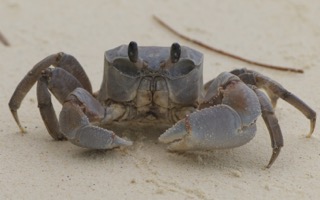Land of crabs

VulcanSpirit
Richard & Alison Brunstrom
Mon 24 Aug 2015 13:15
| The dominant land animals here are crabs. Not quite in the world famous numbers seen at ’nearby’ Christmas Island, but impressive nonetheless. There are three species of hermit crab, and the very large coconut crab which is really a giant hermit crab without a shell, two types of amphibious ghost crab, sally lightfoot crabs on the tidal rocks, and at least three species of land crab one of which is rather large. Sadly I didn’t see all of them, but here are a few: The first guy is a horn-eyed ghost crab Ocypode ceratophthalma. Interestingly these crabs must be able to hear, because the inner surface of their larger claw has a stridulating ridge which they can rub to produce quite a loud noise. These crabs live on sandy beaches, running into the water at quite amazing speed as soon as they detect unusual movement - often 10-15m away. Slightly more terrestrial is its close relative on the right, the smooth handed ghost crab Ocypode cardimanus. These guys live in burrows right up the beach, at and above the tideline and forage in vegetation some distance from the beach. Note the mouthparts folded together under his eyes - crabs have six pairs of modified limbs that act as mouthparts - only the outermost pair are visible here:   The next shot is of the red hermit crab Coenobita perlata, seen here climbing up the sand cliff at the tideline. They push their shells up backwards and can climb extremely well. You can clearly see in the photo the two pairs of antennae that are diagnostic of all crustaceans. Land hermit crabs are air breathing and return to the sea only to lay eggs at its edge.  Next up is the purple hermit, Coenobita brevimana. This is a much bigger chap, the biggest ones being the size of a human hand. They and the red hermits litter the ground at Direction Island, numbered in their thousands.  On the left, a coconut eye’s view of the business end of a purple hermit coming to get you, and on the right a purple hermit’s eyes:   Crabs are not alone on the islands though. There is a tiny gecko Lepidodactylus lugubris:  These lizards are very unusual. They are parthenogenetic (able to reproduce by cloning, without sex), which is a very good adaptation if you are hoping to colonise remote islands as only one successful landing is required. But unlike almost all other parthenogenetic reptiles (there is a handful) these have taken the process a stage further - no males have ever been found; the species seems to have done away with them entirely. This has its risks as a strategy - sexual reproduction enables more genetic diversity which is usually beneficial - but presumably the gains from being able to colonise single handedly outweigh, so far, the loss of diversity. Evolution for these guys is now restricted only to the naturally occurring mutation rate in their DNA. |